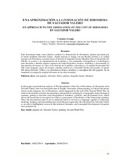Mostrar el registro sencillo del ítem
Una aproximación a La inmolación de Hiroshima de Salvador Valero.
| dc.rights.license | http://creativecommons.org/licenses/by-nc-sa/3.0/ve/ | |
| dc.contributor.author | Araujo Valero, Carmen | |
| dc.date.accessioned | 2014-12-03T15:12:16Z | |
| dc.date.available | 2014-12-03T15:12:16Z | |
| dc.date.issued | 2014-04 | |
| dc.identifier.issn | 1690-3226 | |
| dc.identifier.uri | http://www.saber.ula.ve/handle/123456789/39427 | |
| dc.description.abstract | Este documento tiene como objetivo analizar La Inmolación de Hiroshima, pintura ejecutada por el artista trujillano Salvador Valero; donde muestra el ataque con una bomba atómica a la ciudad japonesa de Hiroshima ocurrido hacia el final de la Segunda Guerra Mundial. Para el desarrollo del estudio se recurre a la interpretación de la pintura y sus contenidos iconográficos e iconológicos para describir y detallar algunos aspectos de orden biográfico, técnico, simbólico y documental, lo que permite reconocer su valor en la historia de la pintura venezolana y el sentido documental del arte como lenguaje capaz de recoger, estudiar, preservar y transmitir hechos del pasado; el aporte del artista Salvador Valero y la consistencia técnica, temática y conceptual del arte popular. Se ha respetado la ortografía original del autor en las citas textuales. | es_VE |
| dc.language.iso | es | es_VE |
| dc.rights | info:eu-repo/semantics/openAccess | |
| dc.subject | Arte popular | es_VE |
| dc.subject | Salvador Valero | es_VE |
| dc.subject | Pintura | es_VE |
| dc.subject | Segunda Guerra Mundial | es_VE |
| dc.title | Una aproximación a La inmolación de Hiroshima de Salvador Valero. | es_VE |
| dc.title.alternative | An approach to The immolation of the city of Hiroshima by Salvador Valero. | es_VE |
| dc.type | info:eu-repo/semantics/article | |
| dc.description.abstract1 | In this paper is presented an analysis of The Immolation of the City of Hiroshima, by the plastic artist Salvador Valero, who was born in the state of Trujillo, Venezuela; in that painting, it is shown the atomic attack on the Japanese city of Hiroshima, which happened by the end of the Second World War. In order to develop the research, the painting is interpreted by studying its iconographic and iconological contents, getting to describe some biographical, technical, symbolic, and documental facts, which allows the researcher to recognize its value as a great piece of the history of the Venezuelan painting. Thus, the documental sense of art is confirmed and it is viewed as a language capable of collecting, studying, keeping, and transmitting facts from the past; especially, the role played by Salvador Valero as an artist is highlighted, moreover the technical, thematic, and conceptual development of popular art is pointed out. | es_VE |
| dc.description.colacion | 55-63 | es_VE |
| dc.description.email | cararaujova@gmail.com | es_VE |
| dc.description.frecuencia | Trimestral | |
| dc.identifier.depositolegal | 200202TR1298 | |
| dc.publisher.pais | Venezuela | es_VE |
| dc.subject.facultad | Núcleo Rafael Rangel (NURR) | es_VE |
| dc.subject.institucion | Universidad de Los Andes | es_VE |
| dc.subject.keywords | Popular art | es_VE |
| dc.subject.keywords | Salvador Valero | es_VE |
| dc.subject.keywords | Painting | es_VE |
| dc.subject.keywords | Second World War | es_VE |
| dc.subject.publicacionelectronica | Academia | |
| dc.subject.seccion | Academia: Artículos de Investigación | es_VE |
| dc.subject.thematiccategory | Artes y Humanidades | es_VE |
| dc.subject.tipo | Revistas | es_VE |
| dc.type.media | Texto | es_VE |
Ficheros en el ítem
Este ítem aparece en la(s) siguiente(s) colección(ones)
-
Academia - Año 13 - Nº 30
Abril - Junio 2014


